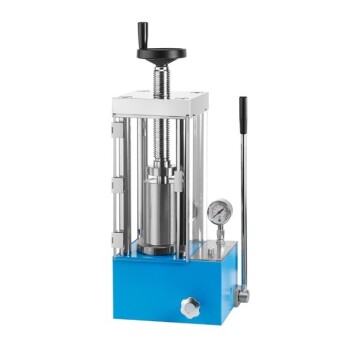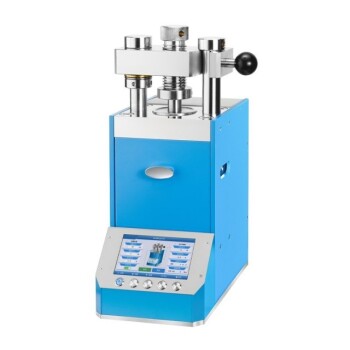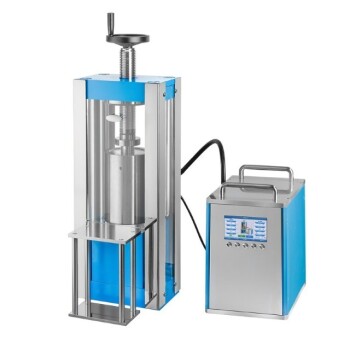At its core, the Split manual press is exceptionally suited for R&D and small batch production because it combines four critical attributes: flexibility in material processing, high precision, a compact design, and significant cost-effectiveness. This unique blend allows research labs and small-scale manufacturers to create consistent, high-quality samples without the spatial footprint or financial investment required by large industrial equipment.
The true value of a Split manual press in an R&D setting is not just its small size or low cost, but its ability to provide precise, repeatable process control. It empowers operators to quickly iterate on new materials and formulations, making it a foundational tool for innovation.
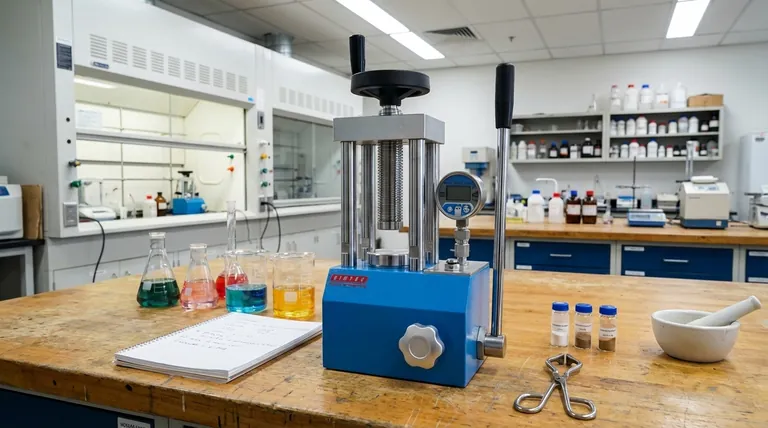
The Core Advantages for R&D Environments
The design of a Split manual press directly addresses the fundamental needs of research and development: rapid iteration, valid data, and efficient use of resources.
Unmatched Flexibility for Experimentation
In R&D, conditions are constantly changing. The press is designed to accommodate this reality.
Operators can easily adapt the machine to process materials of various sizes, shapes, and compositions. This versatility is essential for testing new formulations and exploring different product designs without needing multiple specialized machines.
High Precision and Repeatability
For research to be valid, results must be repeatable. The Split manual press provides the precise process control necessary to ensure this.
This high precision ensures that each sample is created under consistent conditions, which is critical for comparing results across different experiments and building reliable data sets.
Minimal Footprint for Lab Benches
Laboratory space is a valuable and often limited resource. The compact design of a Split manual press is a significant practical advantage.
It can be placed on a standard laboratory bench without monopolizing workspace, leaving room for other essential instruments and procedures.
Operational and Financial Efficiency
Beyond its technical capabilities, the press offers practical benefits that make it an intelligent choice for budget-conscious and agile teams.
Simplicity and Ease of Use
Time spent on complex training is time lost on research. The press features simple, intuitive manual controls.
This user-friendly design means operators require minimal training to become proficient, allowing teams to become productive almost immediately.
Significant Cost-Effectiveness
Large-scale production machinery represents a major capital expenditure. The Split manual press provides a powerful alternative for small-scale needs.
It allows laboratories and startups to produce high-quality experimental samples and small batches in-house, avoiding the high cost and long lead times of outsourcing or investing in oversized equipment.
Understanding the Trade-offs
To make an informed decision, it is crucial to recognize the inherent limitations of a manual press. It is a specialized tool, not a universal solution.
Throughput is Inherently Limited
This machine is designed for precision, not volume. Its output is directly tied to the speed and effort of a human operator.
It is not suitable for medium or high-volume production where speed and automation are the primary drivers of efficiency.
Operator Consistency Becomes a Factor
While the machine itself is precise, the manual nature of its operation can introduce slight variability between different operators or even the same operator over a long day.
For applications requiring absolute, machine-level consistency across thousands of units, an automated system may be more appropriate.
Making the Right Choice for Your Goal
Ultimately, the suitability of a Split manual press depends entirely on your primary objective.
- If your primary focus is rapid prototyping and material testing: The press is an ideal tool, offering the flexibility and precision needed to quickly validate new ideas.
- If your primary focus is small, controlled production runs: It provides a cost-effective method for producing consistent, high-quality batches before committing to larger-scale manufacturing.
- If your primary focus is high-volume, automated manufacturing: You must look beyond a manual press to more robust, automated industrial systems.
This press excels as a precise and accessible tool that bridges the critical gap between initial concept and pilot-scale production.
Summary Table:
| Aspect | Key Features |
|---|---|
| Flexibility | Adapts to various materials, sizes, and shapes for easy experimentation |
| Precision | Ensures repeatable, high-quality results with consistent process control |
| Design | Compact footprint fits on lab benches, saving valuable space |
| Cost-Effectiveness | Low investment compared to industrial equipment, ideal for small-scale use |
| Ease of Use | Simple manual controls require minimal training for quick productivity |
| Limitations | Not for high-volume production; operator-dependent consistency |
Ready to enhance your R&D and small batch production with reliable lab press solutions? KINTEK specializes in lab press machines, including automatic lab presses, isostatic presses, and heated lab presses, designed to meet the precise needs of laboratories. Contact us today to discuss how our equipment can boost your efficiency and innovation!
Visual Guide
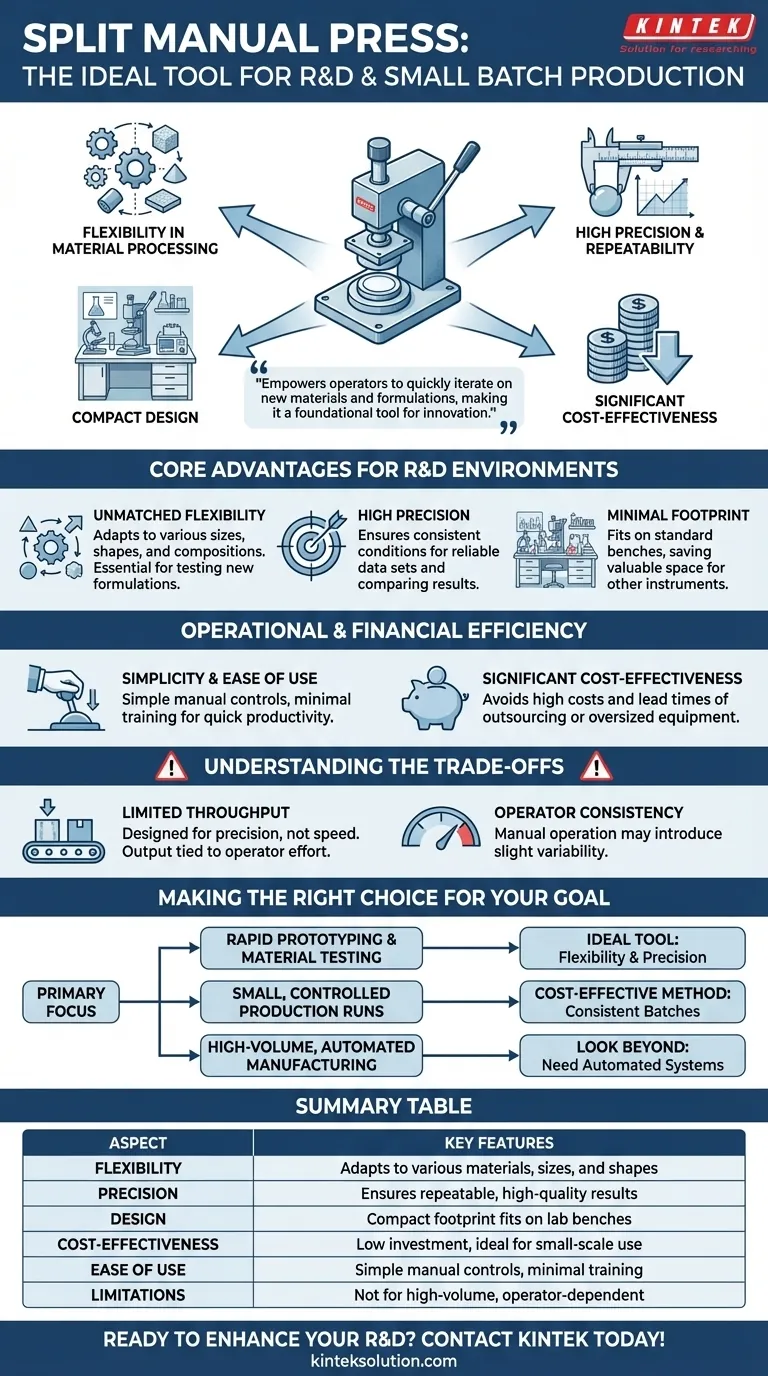
Related Products
- Manual Laboratory Hydraulic Press Lab Pellet Press
- Laboratory Hydraulic Press 2T Lab Pellet Press for KBR FTIR
- Automatic Laboratory Hydraulic Press Lab Pellet Press Machine
- Laboratory Hydraulic Press Lab Pellet Press Button Battery Press
- Automatic Laboratory Hydraulic Press for XRF and KBR Pellet Pressing
People Also Ask
- What feature of the hydraulic portable press helps monitor the pellet-making process? Discover the Key to Precise Sample Preparation
- Why is a precise pressure of 98 MPa applied by a laboratory hydraulic press? To Ensure Optimal Densification for Solid-State Battery Materials
- What are the steps for assembling a manual hydraulic pellet press? Master Sample Prep for Accurate Lab Results
- What is the primary purpose of a manual lab hydraulic pellet press? Ensure Accurate Sample Prep for XRF and FTIR
- What are the advantages of using a hydraulic press for pellet production? Achieve Consistent, High-Quality Samples















